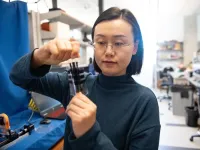(Press-News.org) Researchers at the University of Basel and the University of Zurich have been able to prove that British squirrels carried leprosy bacteria as early as the Middle Ages. Further results revealed a link between the pathogens found in the medieval rodents and those in the local human population during that period.
Skin spots, deformed noses, ulcers: leprosy, is an infectious disease that can bring about some serious symptoms. The bacterium responsible, Mycobacterium leprae, which still infects around 200,000 people each year especially in the Global South, also has a long history in Europe. The international research group led by paleogeneticist Professor Verena Schünemann (University of Basel, formerly University of Zurich) used archaeological findings to identify red squirrels (Sciurus vulgaris) as hosts for M. leprae in medieval England. The researchers also discovered that the leprosy bacteria in medieval squirrels were closely related to those isolated from medieval human skeletons from the same region. The results were published in the journal “Current Biology”.
From squirrels to humans or vice versa?
“This similarity shows us that leprosy bacteria were probably transmitted between animals and humans at that time,” says Schünemann. However, she stresses that, based on current knowledge, it is not clear how this took place. “We don’t know whether the squirrels infected humans or whether humans were the ones to introduce the disease to the animals,” says Schünemann.
There were certainly a number of points of contact between humans and squirrels during the Middle Ages. One key aspect was fur trade, which provided the highly sought-after squirrel fur for the upper echelons of society. Especially in the 11th and 12th centuries, for example, entire coats made of squirrel fur were produced for the various royal families. Furthermore, squirrels were also kept as pets, in royal courts as well as nunneries.
Genetic analysis from 20 milligrams
For their study, the researchers focused on the city of Winchester in southern England. The material necessary for the genetic analysis originates from two different archaeological sites within the city. The human remains were extracted from the location of a former leprosarium, a care facility specifically for people suffering from leprosy. The researchers were able to examine the medieval squirrels thanks to hand and foot bones found at a former skinner’s shop. “We carried out the genetic analyses on the squirrels’ tiny hand and foot bones, which weigh between 20 and 30 milligrams. That is not a lot of material,” explains Christian Urban, first author of the study.
For the researchers, the results are particularly important for predicting leprosy in the future. Because to this day, it is not completely clear how the disease spreads. “Our One Health approach prioritizes finding out more about the role animals played in the spread of diseases in the past”, says Schünemann. “A direct comparison between ancient animal and human strains enables us to reconstruct potential transmission events over time and helps to form conclusions about the long-term zoonotic potential of the disease”, she adds.
The results are therefore relevant for today, as animals still receive very little attention as hosts of leprosy, even though they may be important for understanding the current persistence of the disease despite all attempts to eradicate it.
END
Lepra in the middle ages: New insights on transmission pathways through squirrels
2024-05-03
ELSE PRESS RELEASES FROM THIS DATE:
The Foundational Questions Institute, FQxI, appoints Pinar Emirdag to Board of Directors
2024-05-03
The Foundational Questions Institute, FQxI, a philanthropically-funded science funding agency and think tank, is delighted to announce that Dr Pinar Emirdag has been appointed to the Institute’s Board of Directors.
Emirdag, a financial services executive and entrepreneur, is currently director of Hupomone Ventures, having previously spearheaded industry-changing initiatives at institutions such as JP Morgan, Citi and the London Stock Exchange and at start-ups including Lava Trading and Clearmatics. FQxI’s Chief Operating Officer Kavita ...
Stretchable e-skin could give robots human-level touch sensitivity
2024-05-03
A first-ever stretchy electronic skin could equip robots and other devices with the same softness and touch sensitivity as human skin, opening up new possibilities to perform tasks that require a great deal of precision and control of force.
The new stretchable e-skin, developed by researchers at The University of Texas at Austin, solves a major bottleneck in the emerging technology. Existing e-skin technology loses sensing accuracy as the material stretches, but that is not the case with this new version.
"Much like human skin has to stretch and bend ...
Researchers collaborate with the shipping industry to cut costs, fuel consumption and greenhouse gas emissions in shipping
2024-05-03
A common challenge in shipping occurs when ships arrive promptly at their destination, only to find a crowded harbour. Subsequently, they are often required to wait outside the harbour or anchor until port services and a quayside become available.
According to a report from the International Maritime Organization (IMO), it is not uncommon for ships to spend between 5-10% of their time waiting to enter port. Excessive speeds followed by extended waiting times with engines running result in a notable increase in fuel consumption. This is a problem that impacts both the climate and the economy.
Several European universities, ports, shipping companies and technology firms have now joined forces ...
Towards transparent and antimicrobial surfaces for touch displays
2024-05-03
The interest in antimicrobial solutions for personal and multi-user touch screens, such as tablets and mobile devices, has grown in recent years. Traditional methods like sprayable alcohols or wipes are not ideal for these delicate displays. Antimicrobial coatings applied directly to the glass are a promising alternative, but only if they are transparent and long-lasting. Previous proposed coating solutions, such as photocatalytic metal oxides (e.g., TiO2 and ZnO), have posed some challenges. Additionally, these coatings typically require light and moisture to be antimicrobial and eliminate the microbes present on the surface.
Copper ...
Number of male Oxbridge students from elite schools declined significantly in the middle of the twentieth century, study shows
2024-05-03
The number of male students at the University of Oxford from elite schools declined significantly by the middle of the twentieth century, a new study shows.
In contrast the proportion of female students remained steady. Those with fathers with professional jobs rose dramatically by the 1960s, according to the analysis.
At the beginning of the century around 25 to 35 per cent had fathers in professional occupations. This had risen to around 50 per cent among those arriving at Oxford in the 1960s.
The research, published in the journal Gender & History, was ...
A cost-efficient path to a renewable energy grid for Australia
2024-05-03
A model charts the most cost-efficient path to a fully renewable electricity grid for Australia. Raheel Ahmed Shaikh and colleagues modeled possible scenarios for Australia’s eastern and western grids, using solar and wind generation, short-to-long-term energy storage, and financial input data to explore low-cost capacity mix. Going completely renewable would require significant expansion of both generation and storage. Interconnecting the two grids would reduce generation capacity needs by 6% and storage power capacity needs by 14%. The least cost renewable-only grid would be dominated by wind, ...
Leadership in MS Rehabilitation recognized: John DeLuca, PhD, awarded 2024 Giants of MS® Honor
2024-05-03
East Hanover, NJ – May 3, 2024 – John DeLuca, PhD, of Kessler Foundation was named recipient of the 2024 Giants of Multiple Sclerosis® award for rehabilitation. He was one of seven inductees announced by NeurologyLive® and the Consortium of Multiple Sclerosis Centers (CMSC) this week. Dr. DeLuca is senior vice president, Research and Training at the Foundation and a professor in the departments of Physical Medicine & Rehabilitation and Neurology at Rutgers New Jersey Medical School.
Established in 2021, the Giants of Multiple Sclerosis award honors trailblazers, innovators, and visionaries ...
High rates of hip osteoarthritis among older adults with spinal deformity
2024-05-03
Waltham — April 30, 2024 — One-third of patients undergoing surgery for adult spinal deformity (ASD) also have severe osteoarthritis (OA) of the hip – which is associated with worse spinal alignment and physical functioning, reports a study in The Journal of Bone & Joint Surgery. The journal is published in the Lippincott portfolio in partnership with Wolters Kluwer.
These differences persist even following operative treatment of ASD, ...
ChatGPT can be helpful for Black women’s self-education about HIV, PrEP
2024-05-03
Waltham — May 3, 2024 — The artificial intelligence (AI) chatbot called ChatGPT is a powerful way for Black women to educate themselves about HIV prevention, as it provides reliable and culturally sensitive information, according to a study in The Journal of the Association of Nurses in AIDS Care (JANAC), the official journal of the Association of Nurses in AIDS Care. JANAC is published in the Lippincott portfolio by Wolters Kluwer.
"In addition to immediately available information, regardless of time or geographic location, privacy ...
Research quantifies “gap” in carbon removal for first time
2024-05-03
New research involving the University of East Anglia (UEA) suggests that countries’ current plans to remove CO2 from the atmosphere will not be enough to comply with the 1.5 ºC warming limit set out under the Paris Agreement.
Since 2010, the United Nations environmental organisation UNEP has taken an annual measurement of the emissions gap - the difference between countries’ climate protection pledges and what is necessary to limit global heating to 1.5 ºC, or at least below 2 ºC.
The ...





